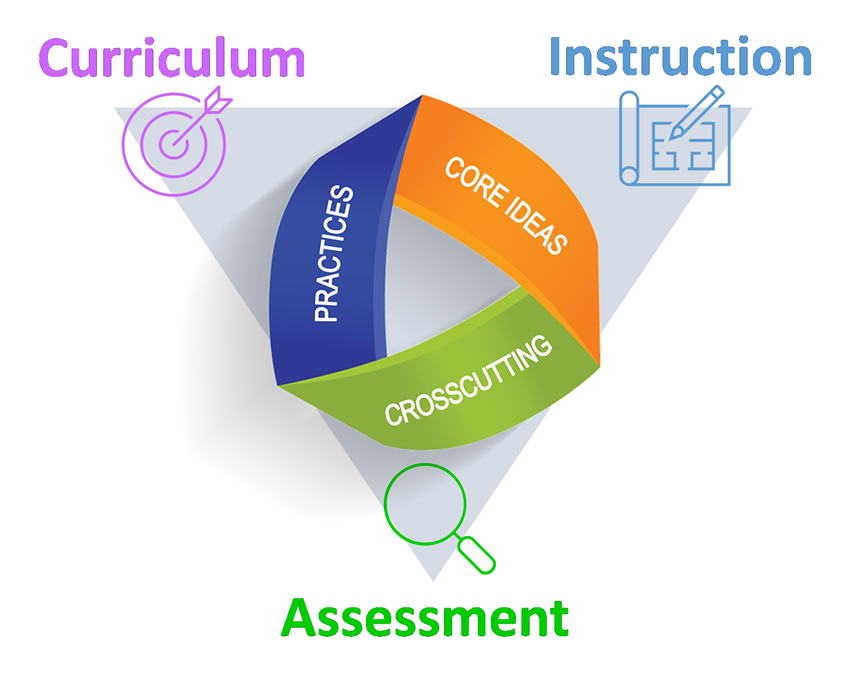Resources
SIPS Resources
The SIPS partners are producing a wide range of science assessment resources for public access and use that are coordinated and aligned across all parts of a standards-based system of curriculum, instruction, and assessment. With coherence as a guiding principle, SIPS is engaging state and local educators from all six partner states to identify meaningful bundles of Next Generation Science Standards (NGSS) performance expectations for grades 5 and 8 and to create four unit maps (i.e., instructional frameworks) to cover those expectations. Each unit map is accompanied by a suite of curriculum, instruction, and assessment resources designed to support high-quality, three-dimensional science teaching and learning along a year-long instructional pathway.

For more information about the SIPS resources, see the SIPS Assessment Model Interpretive Guide (.pptx, .pdf).
Grade 5 Unit 1: Matter and Its Interactions
The Grade 5 Unit 1 topic, “Matter and Its Interactions,” organizes the Next Generation Science Standards performance expectations with a focus on helping students develop an understanding of matter and its interactions and the structure, properties, and conservation of matter.
|
Grade 5 Unit 1 Curriculum, Instruction, and Assessment Resources |
||||
|
Curriculum
|
||||
|
Assessment
|
||||
|
Instruction
|
||||
*Embedded within Unit Map / Instructional Framework
Grade 5 Unit 2: Matter and Energy in Organisms and Ecosystems
The Grade 5 Unit 2 topic, “Matter and Energy in Organisms and Ecosystems” organizes the Next Generation Science Standards performance expectations with a focus on helping students develop an understanding of the interconnectedness of organisms and environments within ecosystems, and how matter cycles and energy flows within these ecosystems that enable living things to grow and survive.
|
Grade 5 Unit 2 Curriculum, Instruction, and Assessment Resources |
||||
|
Curriculum
|
||||
|
Assessment
|
|
|||
|
Instruction
|
||||
*Embedded within Unit Map / Instructional Framework
Grade 5 Unit 3: Earth Systems and the Solution of Water Problems
The Grade 5 Unit 3 topic, “Earth Systems and the Solution of Water Problems,” organizes performance expectations with a focus on the interconnectedness of how different Earth systems interact with each other and how water plays an important role for each of the four Earth systems, especially the biosphere.
|
Grade 5 Unit 3 Curriculum, Instruction, and Assessment Resources |
||||
|
Curriculum
|
||||
|
Assessment
|
||||
|
Instruction
|
||||
*Embedded within Unit Map / Instructional Framework
Grade 5 Unit 4: Earth and its Gravitational Force and Motion
The Grade 5 Unit 4 topic, “Earth and its Gravitational Force and Motion,” organizes the Next Generation Science Standards performance expectations with a focus on helping students develop an understanding of how Earth’s spin is related to how much sunlight is received in any location, how Earth’s gravitational force is always directed downwards, and how the distance of Earth from the sun and stars influences their brightness.
|
Grade 5 Unit 4 Curriculum, Instruction, and Assessment Resources |
||||
|
Curriculum
|
||||
|
Assessment
|
||||
|
Instruction
|
||||
*Embedded within Unit Map / Instructional Framework
Grade 8 Unit 1: Forces and Energy
The Grade 8 Unit 1 topic, “Forces and Energy,” organizes the Next Generation Science Standards performance expectations with a focus on helping students develop an understanding of the motion of objects and how interactions between objects can be explained and predicted.
|
Grade 8 Unit 1 Curriculum, Instruction, and Assessment Resources |
||||
|
Curriculum
|
||||
|
Assessment
|
||||
|
Instruction
|
||||
*Embedded within Unit Map / Instructional Framework
Grade 8 Unit 2: Gravity and Motion of Objects in the Solar System
The Grade 8 Unit 2 topic, “Gravity and Motion of Objects in the Solar System,” organizes the Next Generation Science Standards performance expectations with a focus on helping students deepen their knowledge of the force of gravity between objects with mass and its role in keeping planetary objects in orbit within the solar system, and of Earth’s place in the universe.
|
Grade 8 Unit 2 Curriculum, Instruction, and Assessment Resources |
||||
|
Curriculum
|
||||
|
Assessment
|
||||
|
Instruction
|
||||
*Embedded within Unit Map / Instructional Framework
Grade 8 Unit 3: Understanding Earth History and the Origin of Species
The Grade 8 Unit 3 topic, “Understanding Earth History and the Origin of Species,” organizes the Next Generation Science Standards performance expectations with a focus on helping students deepen their knowledge of evidence of a common ancestor interpreted through fossil records and how differences in their structure help explain present day organisms, and how rock strata help us explain the history of Earth.
|
Grade 8 Unit 3 Curriculum, Instruction, and Assessment Resources |
||||
|
Curriculum
|
||||
|
Assessment
|
||||
|
Instruction
|
||||
*Embedded within Unit Map / Instructional Framework
Grade 8 Unit 4: Providing Solutions to Problems Using Simple Wave Properties
The Grade 8 Unit 4 topic, “Providing Solutions to Problems Using Simple Wave Properties,” organizes the Next Generation Science Standards performance expectations with a focus on helping students deepen their knowledge of properties of mechanical light and light waves and how they can be used to define and solve engineering problems. Students learn how to determine success criteria and constraints needed to solve problems related to properties and behaviors of simple waves.
|
Grade 8 Unit 4 Curriculum, Instruction, and Assessment Resources |
||||
|
Curriculum
|
||||
|
Assessment
|
||||
|
Instruction
|
||||
*Embedded within Unit Map / Instructional Framework



